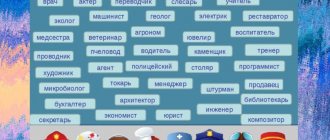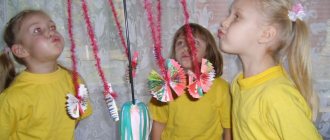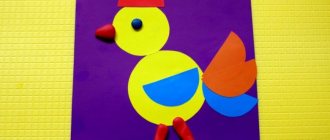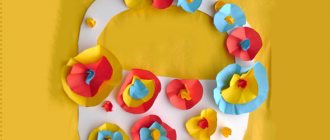Summary of the plot-role-playing game “Builders” in the 2nd junior group
Abstract
plot-role-playing game " Builders "
in the 2nd junior group
Developed and carried out
Kolycheva Elena Petrovna
group teacher
Fatezh 2016
The purpose of the plot-role-playing game “ Builders ”
:
with each other while
Tasks:
Educational:
• improve specific ideas about construction
, its stages;
• develop intelligence;
• develop the ability to carry out construction
, achieve the intended result.
Educational:
• develop thinking, imagination, fine and gross motor skills;
• develop communication skills, artistic taste, initiative, creative activity and imagination, imaginative thinking, self-awareness;
• develop the ability to creatively develop the plot of the game
.
Educational:
• promote moral development;
• promote the manifestation of empathy, sympathy for the characters, the desire to help them;
• cultivate a desire to work in a team;
• create a joyful mood
, emotional
mood
;
• consolidating knowledge about blue-collar professions, instilling respect for work.
Progress of the game:
The teacher addresses the children sitting on chairs:
Today guests came to us to see how we can play. Say hello to them.
(Children say hello.)
Educator:
Now sit back and listen to what I have to tell you.
(Teacher's story)
In one forest there lived a mouse - norushka, a frog - a frog, a bunny - a runner, a fox - a little sister, a top - a gray barrel and a bear - a stomp. They lived amicably, never quarreled, did not offend each other and did not allow themselves to be offended. All summer and all autumn they played, frolicked in sunny meadows and completely forgot that a cold, frosty winter would soon come.
And so it happened. The last leaves flew off the trees and a white snowball fell to the ground. Our friends became sad and decided to go look for housing.
(Children wearing masks of the heroes of the story go to the teacher and together walk around the group in search of housing
)
Educator:
They walked for a long time and finally saw the house. They approached him, looked out the window, they saw that there was no one there, they went into the house and began to live in it.
They live and live well and do not know grief, they sing songs and have fun. Only one bear - trampling - does not take part in this fun, because what is a bear supposed to do in winter?
Children answer:
Sleep
Educator:
Right. All bears go to bed in winter, so our bear immediately went to bed and fell asleep so soundly that he didn’t even notice how in his dream he accidentally pushed the wall with his paw, that the house could not stand it and fell apart.
The animals began to cry, and the bear woke up from their crying and saw what he had done. But there is nothing to be done, the friends decided to build a new house
.
But since they did not know how to build
, they decided to call
the builders from the kindergarten
.
Construction games for children of the second junior group card index (junior group)
Design file
"Construction Games"
in the second junior group
September
1. Topic: “Tracks for nesting dolls”
Objectives: to develop children’s ability to build paths from bricks; encourage the desire to play with buildings; cultivate a desire to communicate during play action.
2. Topic: “Furniture for kindergarten”
Objectives: develop the ability to create models of various pieces of furniture; develop interest in working with building materials; cultivate interest in joint activities with adults.
3. Topic: “Path in the garden”
Objectives: to promote the development of basic design skills in children; encourage the desire to play around with the building.
4. Topic: “Slide with ladders”
Objectives: improve basic design skills; expand children's understanding of objects in their immediate environment.
October
1. Topic: “Truck tracks”
Objectives: develop the ability to build paths from bricks; arouse interest in playing with the building; cultivate a caring attitude towards the buildings of peers.
2. Topic: “Furniture for dolls”
Objectives: to develop in children the ability to build according to a model and analyze a building, to use parts of different colors in construction; develop a desire for playful and verbal communication.
3. Topic: “Table and chair”
Objectives: to develop in children the ability to distinguish and name building parts (cube, plate, brick, to develop the ability to use parts taking into account their structural properties (stability, shape, size); to cultivate interest in playing out buildings together.
4. Topic: "Car"
Objectives: to develop the ability to carry out construction according to a model; improve design skills; cultivate interest in objects of the immediate environment.
5. Topic: “Gates for different cars”
Objectives: to develop the ability to build a building according to a model, using additional materials according to your plan; develop the skill of independently organizing play with buildings; cultivate a desire to share parts and toys with play partners.
November
1. Topic: “Zoo” (construction of cages for animals)
Objectives: develop the ability to build animal cages using bricks according to a model. Develop partnerships and verbal interaction during the gameplay. Cultivate an interest in the animal world.
2. Topic: “Furniture for dolls”
Objectives: develop the ability to build according to a model, using parts of different colors, analyze the building. Develop a desire for playful and verbal communication.
3. Topic: “Tower. Introduction to the ''pyramid principle''”
Objectives: develop the ability to design from drawings and photographs. Reinforce the concepts of “high” and “low”.
4. Topic: “Table and chair for Mishutka”
Objectives: to develop in children the ability to distinguish and name building parts (cube, plate, brick, the ability to use them taking into account their structural properties (stability, shape, size).
December
1. Topic: “Room for dolls”
Objectives: to train children in building models of furniture based on ideas. Develop the ability to use in work such a property of building parts as interchangeability.
2. Topic: “Gates are wide and narrow”
Objectives: improve the ability to construct various buildings according to given conditions. Clarify the meaning of the concepts “wide - narrow”.
3. Topic: “Garland - a chain of rings”
Objectives: develop the ability to glue rings from multi-colored strips of paper. Create a desire to create New Year's attributes with your own hands. Cultivate accuracy and attention; develop fine motor skills of the hands.
4. Topic: “Furniture for the Snow Maiden”
Tasks: continue to introduce children to the character - the Snow Maiden. Expand children's understanding of familiar objects in the world around them. Develop the ability to play with your buildings.
January
1. Topic: “Dog kennel”
Objectives: improve the ability to design from drawings and photographs. Continue to form ideas about the concepts of “high - low”.
2. Topic: “Furniture for a doll”
Objectives: improve the ability to carry out construction in a certain sequence, change buildings using the method of building on top. Cultivate interest in playing with dolls.
3. Topic: “Furniture for Santa Claus”
Objectives: expand children’s ideas about the New Year’s character. Continue to develop children’s ability to complete buildings in the required sequence, and independently come up with a plot to play out their construction.
4. Topic: “House for a fox”
Objectives: develop the ability to build a house for a fox and play with your construction. Foster independence, the desire to take care of the character in the fairy tale.
February
1. Topic: “Funny snakes” (paper)
Objectives: to develop children’s ability to see the possibilities of aesthetic transformation of objects. Develop activity and independence.
2. Topic: “House for a bunny”
Objectives: to develop children’s ability to build a house according to their own design, to play with their construction. Form game interaction while playing.
3. Topic: “Airplane” (paper)
Objectives: to develop the ability to make paper crafts. To develop children’s interest in “revitalizing” the applicative image.
4. Topic: “Furniture store”
Objectives: to develop the ability to carry out buildings of different sizes, heights, widths. Foster friendly interaction with peers in joint games.
March
1. Topic: “Building a house”
Objectives: to develop children’s ideas about the shape, size and color of objects. To develop an interest in designing houses.
2. Topic: “Furniture for dolls”
Objectives: develop the ability to build according to a model, analyze a building, and use parts of different colors in it. Develop a desire for playful and verbal communication.
3. Topic: “House for a nesting doll”
Objectives: to develop the ability to create buildings with internal free space. Cultivate a desire to bring joy to your favorite toy.
4. Topic: “Gate for a truck”
Objectives: to improve the ability to build a building according to a model, using additional materials according to your plan. Develop the ability to play with buildings, share parts and toys with other children.
April
1. Topic: “Zoo”
Objectives: continue to develop the ability to build animal cages using bricks placed on a narrow long side and a narrow short side close to each other or at a certain distance from each other. Develop cognitive interest, memory, imagination.
2. Theme: "Tower"
Objectives: develop the ability to design from drawings and photographs. To form an understanding of the concepts of “high - low”. Develop the ability to play with buildings, share parts and toys with other children.
3. Topic: “Beautiful house for a bunny”
Objectives: to form in children an idea of their own importance - I can help the bunny. To develop children’s ability to design using drawings and photographs.
4. Topic: “Dog kennel”
Objectives: develop the ability to independently construct a familiar object, using drawings and photographs if desired. Reinforce the concepts of “high - low”.
May
1. Topic: “Houses on our street”
Objectives: to improve children’s skills in building models of houses of different heights. Develop the ability to use your buildings in story games.
2. Topic: “House for a gnome”
Objectives: develop the ability to build a house for a character and play around with it. Cultivate the desire to bring joy to your favorite toy.
3. Topic: “Town”
Objectives: to promote children's initiative; encourage the desire to use acquired constructive skills in play.
4. Topic: “Bridges”
Objectives: to improve children’s skills in constructing buildings according to a diagram. Develop the ability to play with buildings, share parts and toys with other children.
Educator: Gulieva Z.A.
Source: stroitelnye_igry.docx
Card index of constructive games in the younger group
"Arrange your room"
Purpose of the game: development of logical thinking in preschoolers.
Material: sheet of paper (35*45cm), construction set, plane geometric shapes
Progress of the game. The teacher offers the children a sheet of paper (35*45 cm) and says that this is the floor of the doll’s room, asks them to build it with bricks (the walls of the room), leaving gaps for the window and door. After the children do this, take out the sheet and place it next to the constructed room. Then he takes out geometric shapes and offers to lay them out on paper, selecting pieces of furniture that are similar in shape (a square is a stool, a rectangle is a bed, etc.). The teacher reviews the resulting diagram with the preschoolers and asks them to arrange “furniture” according to it in a room built with bricks. At the end of the work, the children compare the image with the building.
“Relationship of geometric bodies and figures”
Purpose of the game: to teach children to correlate images of geometric shapes and construction parts of a construction set.
Material: Cards with images of geometric shapes, construction set.
Progress of the game. Preschoolers are asked to look at images of geometric bodies, and then at the geometric shapes shown below. The teacher asks to find the building parts shown on the card and show those sides that have the shape of the geometric shapes shown under the card.
The task becomes more complicated if children are asked to correlate geometric shapes and bodies without using construction parts.
“Putting on the details”
Purpose of the game: development of logical thinking in preschoolers.
Material: diagram cards, construction parts.
Progress of the game. Preschoolers are given two cards: on one, in the form of a diagram, various towers are depicted, on the other, building parts that should be selected to solve this problem. Target
task: place the parts in the outline so that they come into contact with the surface of the sheet on one of the faces. In the process of solving a task, the teacher clarifies what parts the child uses, what color, what shape of edges this or that part has, how many edges the part has, how many parts went into assembling the image.
Constructive games for children 5-7 years of age.
"Build according to the model"
Purpose of the game: to teach children to build structures using a finished model.
Material: three-dimensional models, construction kit.
Progress of the game. Build simple structures from building materials and cover them with paper or fabric to create three-dimensional models. There is a general idea of the design, but you have to guess what parts it is assembled from. Invite the children to build buildings using these models. (Children of the preparatory group construct more complex structures based on the depicted undivided three-dimensional models.)



